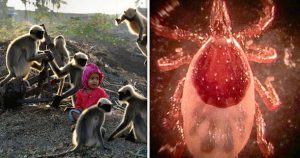Monkeypox:

The US started surveillance on people travelling from Nigeria, who may have had contact with the individuals infected with Monkeypox.
- It is a viral zoonotic disease (transmission from animals to humans) and is identified as a pox-like disease among monkeys hence it is named Monkeypox.
- It is endemic to Nigeria.
- It is caused by monkeypox virus, a member of the Orthopoxvirus genus in the family Poxviridae.
- The natural host of the virus remains undefined. But the disease has been reported in many animals.
- Animals known to be sources of Monkeypox virus include monkeys and apes, a variety of rodents (including rats, mice, squirrels and prairie dogs) and rabbits.
- It was first reported in 1958, in monkeys in the Democratic Republic of Congo (DRC) and in humans in 1970, also in the DRC.
- In 2017, Nigeria experienced the largest documented outbreak, 40 years after the last confirmed case.
- Subsequently, the disease has been reported in many West and Central African countries.
- Symptoms:
- Infected people break out in a rash that looks a lot like chicken pox. But the fever, malaise, and headache from Monkeypox are usually more severe than in chicken pox infection.
- In the early stage of the disease, Monkeypox can be distinguished from smallpox because the lymph gland gets enlarged.
- Transmission:
- Primary infection is through direct contact with the blood, bodily fluids, or cutaneous or mucosal lesions of an infected animal. Eating inadequately cooked meat of infected animals is also a risk factor.
- Human-to-human transmission can result from close contact with infected respiratory tract secretions, skin lesions of an infected person or objects recently contaminated by patient fluids or lesion materials.
- Transmission can also occur by inoculation or via the placenta (congenital monkeypox)




